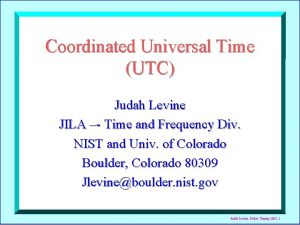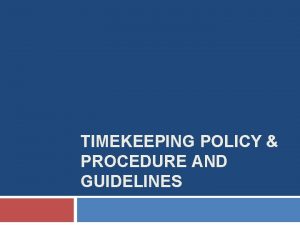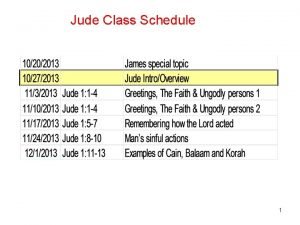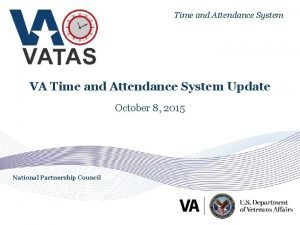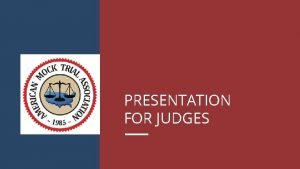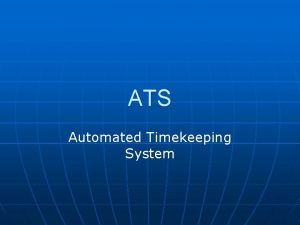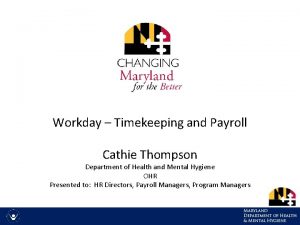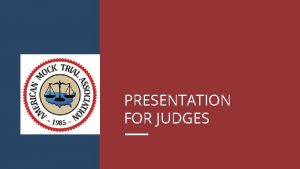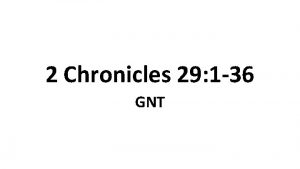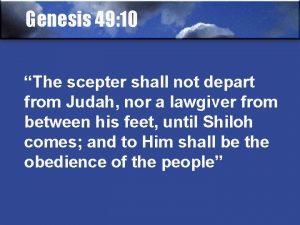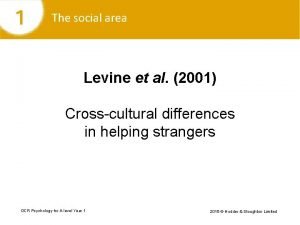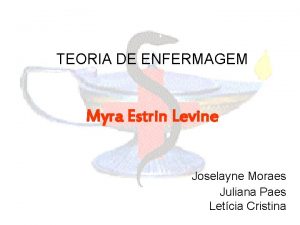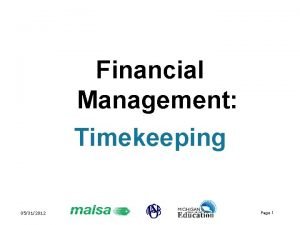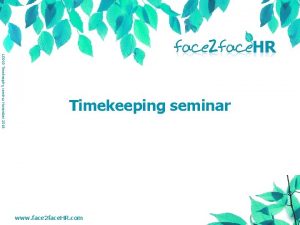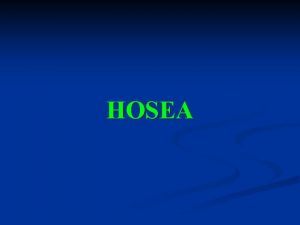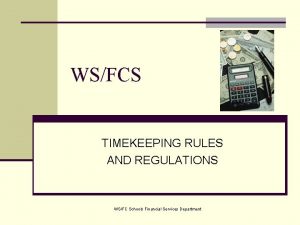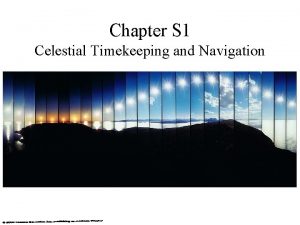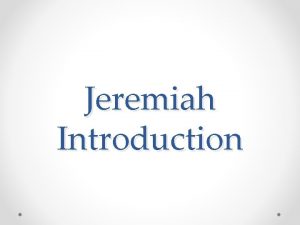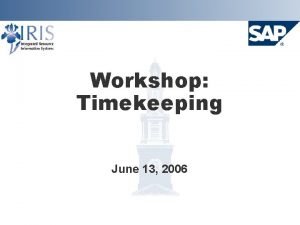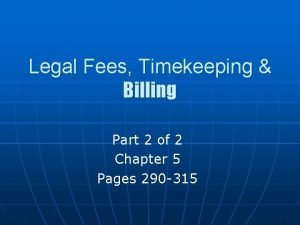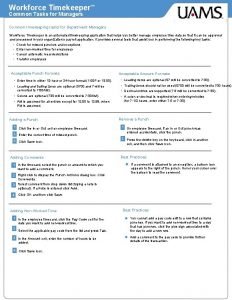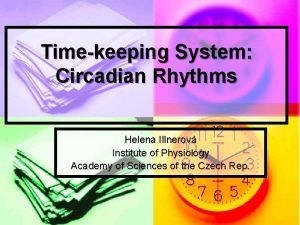Introduction to Time and Timekeeping Judah Levine Time


























- Slides: 26

Introduction to Time and Timekeeping Judah Levine Time and Frequency Division NIST/Boulder jlevine@boulder. nist. gov Judah Levine, NIST, CENAM, Sept 2012: 1

Outline Introductory background n Requirements of a time service operated by a timing laboratory n The error budget for time dissemination n Description of methods with examples n – advantages and limitations Judah Levine, NIST, CENAM, Sept 2012: 2

Background n Laboratory is generating a local estimate of UTC: UTC(lab) – Time scale methods in future talk n UTC(lab) is steered to UTC with an uncertainty adequate for the time service – 100 s for NTP, telephone services, radio time signals, … Judah Levine, NIST, CENAM, Sept 2012: 3

Requirements - 1 n Integrity – Time signals must be protected so they are not modified or changed during transmission – Easy: • Telephone service • Radio broadcast service • Authenticated Internet service – Hard: • Normal Internet services Judah Levine, NIST, CENAM, Sept 2012: 4

Requirements - 2 n Availability – Service should not have single point of failure • Multiple sources at different locations – Minimize Time to Repair – Balanced with Cost – GNSS signals can be jammed or spoofed • Total reliance on GNSS signals possible longterm problem Judah Levine, NIST, CENAM, Sept 2012: 5

Requirements - 3 n Accuracy – Service should transmit UTC(lab) only when operating correctly – Should transmit nothing or error message when failed • Some services do not use this principle – Example: implementations of NTP • Principle can never be 100% reliable Judah Levine, NIST, CENAM, Sept 2012: 6

Requirements - 4 n Technical Traceability – Each link between user and UTC should be calibrated with delay and uncertainty • Magnitude consistent with user requirements n Legal Traceability – Traceability can be documented and proven in legal proceedings • Log files and documents show properation and also errors n Users are responsible for traceability with assistance from timing laboratory Judah Levine, NIST, CENAM, Sept 2012: 7

The Error Budget n Internal accuracy of the time source – Usually not the limiting factor n The transmission delay – This is usually the hard part – Uncertainty often limits traceability n Statistics of the user’s clock and the measurement process – Is calibration interval consistent with accuracy requirement? – Dynamic, adaptive calibration process Judah Levine, NIST, CENAM, Sept 2012: 8

Methods of Time Dissemination Simple one-way method n One-way method with model of delay n Common-view n Partial two-way method n Full Two-way method n Judah Levine, NIST, CENAM, Sept 2012: 9

Simple one-way method - 1 n Ignore network delay completely – Delay << required accuracy n Simple broadcasts – Low-frequency services (WWVB, …) • 60 k. Hz, 2 × 50 k. W covers most of US – Short-wave services (WWV, …) • 2. 5 MHz, … delay, coverage variable – Internet service in broadcast mode (NTP) • Delay, coverage very variable Judah Levine, NIST, CENAM, Sept 2012: 10

Simple one-way method - 2 Simple receiver and transmitter n Transmission cost does not depend on number of receivers n Receiver is passive n Timing error < 1 s, often < 20 ms n Traceability possible with adequate log files n Judah Levine, NIST, CENAM, Sept 2012: 11

One-way with delay model GPS 65 ns, Ionosphere delay from model or L 1 -L 2 dispersion Geometric delay, 65 ms estimated using ephemeris and known position Geophysical effects, earth models, 1 ns 5 ns, Troposphere delay from T, RH, or multiple satellites Receiver Calibration, Multipath, 10 ns Judah Levine, NIST, CENAM, Sept 2012: 12

Common-view method Path delays are nearly equal and cancel in the difference Source clock cancels too Source The time is S ←δ→ Rcvr 1 Rcvr 2 T 1= t(1) – (S + ) T 2= t(2) – (S + ) t= T 1 -T 2= t(1)-t(2) Judah Levine, NIST, CENAM, Sept 2012: 13

Common View Sources n n GNSS Signals Television Broadcasts – Synchronization pulse in blank line n FM radio signals – Stereo sub-carrier n Phase of mains voltage – Within building or small area n n Loran signals (no longer in US) Source is used passively at no cost Judah Levine, NIST, CENAM, Sept 2012: 14

Common View Limitations n Paths to receivers have very different un-modeled delays – Calibration of local equipment – Atmospheric delay n Receivers too far apart to see the physical transmitter Judah Levine, NIST, CENAM, Sept 2012: 15

Com ref All in view melting pot S 1 S 2 S 3 S 4 S 5 S 6 S 7 S 8 1 -C 2 -C 3 -C 4 -C 5 -C 6 -C 7 -C 8 -C Rcvr 1 Rcvr 2 1=(S 1+S 2+S 3+S 4)/4 2=(S 5+S 6+S 7+S 8)/4 T= 1 - 2 Judah Levine, NIST, CENAM, Sept 2012: 16

Partial two-way method n Delay is stable and is white pm – Measure only occasionally – Unique to PTP/1588 – Useful only in special cases • Problems in wide-area networks • False-tickers and the trust problem Judah Levine, NIST, CENAM, Sept 2012: 17

Full Two-way n Measure round-trip delay on every calibration – Delay is not stable and not white pm over longer periods – Transmission delay is one-half of measured value • Delay is symmetric on the average Telephone system using ACTS n Internet using full NTP n Judah Levine, NIST, CENAM, Sept 2012: 18

Real-world limitations n Inbound and outbound delays are not equal – Realized as a two-way physical circuit with some one-way components • Physical component dispersion – Realized with a reversible one-way physical circuit • Time dispersion – Realized using a packet network • Asymmetric queuing and routing delays Judah Levine, NIST, CENAM, Sept 2012: 19

Effect of Asymmetry - 1 n Method assumes one-way delay is one-half of round-trip value. Time error is given by 0≤ k ≤ 1 Judah Levine, NIST, CENAM, Sept 2012: 20

Effect of asymmetry - 2 k=1, = /2 0 Round-trip delay→ k=0, = - /2 Smaller delay has smaller asymmetry error Judah Levine, NIST, CENAM, Sept 2012: 21

NTP Service model n Operate servers at many locations – Minimizes delay error for all users – No single point of failure – How are remote servers synchronized? • Time link to source of UTC(lab) n Performance limited by delay jitter and asymmetry – Few percent of round-trip measurement • Accuracy < 50 ms, often < 10 ms, maybe ~ 1 ms Judah Levine, NIST, CENAM, Sept 2012: 22

Asymmetry – the bottom line n Static asymmetry generally cannot be detected or removed – Limits accuracy of any protocol – Multiply-connected networks sometimes help in detecting asymmetry • Apparent time difference over different paths Judah Levine, NIST, CENAM, Sept 2012: 23

Summary - 1 n One-way methods are simple and are good enough for many applications – Path delay can be ignored – Path delay can be modeled adequately n Common-view depends on equality of delays along two one-way paths – Requires data exchange between stations n Neither method can attenuate local effects Judah Levine, NIST, CENAM, Sept 2012: 24

Summary - 2 n n Two-way depends on equality of delay in opposite direction along a single path Limited by the symmetry of the link delay between the transmitter and the receiver – Magnitude of the delay not important – Message format not important n Error in time data proportional to asymmetry and delay – Shorter paths will always have smaller errors Judah Levine, NIST, CENAM, Sept 2012: 25

For more information n List of publications of the NIST time and frequency division are in the publications menu of our web page: tf. boulder. nist. gov Many of these publications are on-line n “Time and Frequency Measurement” by C. Hackman and D. B. Sullivan, published by the American Association of Physics Teachers, 1996. n Judah Levine, NIST, CENAM, Sept 2012: 26
 Judah levine
Judah levine Judah levine
Judah levine Old testament prophets timeline
Old testament prophets timeline Timekeeping policy
Timekeeping policy Kingdoms of israel and judah
Kingdoms of israel and judah Mary mother of jesus family tree
Mary mother of jesus family tree Electronic timekeeping
Electronic timekeeping Va time and attendance system
Va time and attendance system Amta timekeeping
Amta timekeeping Automated timekeeping system
Automated timekeeping system Workday timekeeping system
Workday timekeeping system Amta timekeeping
Amta timekeeping Kronos timekeeping ucsb
Kronos timekeeping ucsb Manusonic timekeeping
Manusonic timekeeping Moreland and levine's model of group socialization
Moreland and levine's model of group socialization Meiosis chromosome number
Meiosis chromosome number Nissan meaning hebrew
Nissan meaning hebrew Hezekiah king of judah facts
Hezekiah king of judah facts Algonquian clothing
Algonquian clothing Genesis 49 10
Genesis 49 10 You're the lion of judah the lamb that was slain
You're the lion of judah the lamb that was slain Genesis 49:10
Genesis 49:10 When the romans conquered judah they renamed it
When the romans conquered judah they renamed it When the romans conquered judah they renamed it
When the romans conquered judah they renamed it Name given to judah by romans refers to the philistines
Name given to judah by romans refers to the philistines How does levine link to social area
How does levine link to social area Levine enfermagem
Levine enfermagem

